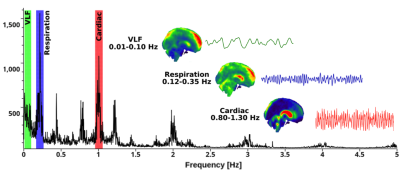Functional Connectivity & Brain Perfusion: Cardiorespiratory brain pulsations
1University of Oulu, Oulu, Finland
Synopsis
A century after the detection of three pulsation mechanisms in the human brain during neurosurgical procedures, ultrafast fMRI enables exact depiction of the vasomotor waves, respiratory and cardiac pulsations non-invasively. Arterial blood impulses and respiration induced venous pulsations form continuosly propagating CSF waves that flush brain paravascular spaces and drive the glymphatic solute transport. Sleep increases all these pulsations in areas of increased brain interstiatial flushing. Brain diseases such as Alzheimer's disease, epilepsy, and PCNSL invading the perivascular space, significantly alter the pulsation dynamics of the brain, which enables direct visualization of individual pathology with ultrafast BOLD scans.
Acknowledgements
Academy of Finland, Jane & Aatos Erkko Foundation and Finnish Brain Foundation are cordially acknowledged for their research funding.References
1. Kiviniemi V, ..., Nedergaard M. Ultrafast MR encephalography of physiological brain activity - glymphatic pulsation mechanisms? 2016 JCBFM 36(6):1033-45. doi: 10.1177/0271678X15622047
2.Helakari H,..., Nedergaard M& Kiviniemi V. Human NREM Sleep Promotes Brain-Wide Vasomotor and Respiratory Pulsations. J NSci 2022, doi.org/10.1523/JNEUROSCI.0934-21.2022
3. Raitamaa L, ..., Kiviniemi V. Spectral analysis of physiological brain pulsations affecting the BOLD signal. Hum Brain Mapp. 2021 Sep;42(13):4298-4313. doi: 10.1002/hbm.25547.
4. Rajna Z, ..., Nedergaard M, Kiviniemi V. Cardiovascular brain impulses in Alzheimer's disease. Brain 2021 Mar 31, doi: 10.1093/brain/awab144.
5. Kananen J,..., Kiviniemi V, Respiratory-related brain pulsations are increased in epilepsy – a two-center functional MRI study, Brain Com 2020, 2(2), https://doi.org/10.1093/braincomms/fcaa076
Figures
